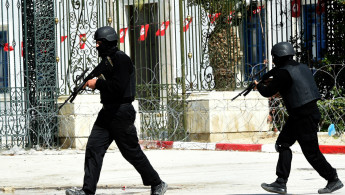At least 20 killed in Tunis museum attack
Gunmen attacked Tunisia's national museum with 20 people confirmed killed, mostly tourists. The siege, now over, is the worst attack on a tourist site in years.
3 min read
Security measures are taken outside Bardo Museum, near the parliament [Anadolu/Getty]
At least 20 people were killed, including 17 foreign tourists, when gunmen attacked Tunisia's Bardo museum in the capital Tunis, Prime Minister Habib Essid said on Wednesday.
Polish, Italian, German and Spanish tourists were among the dead. A Tunisian citizen and a policeman were also killed in the attack, Essid said.
Two gunmen have also been killed, bringing the death toll to 21, but some attackers may have escaped, authorities said.
Private television Wataniya showed masked Tunisian security forces escorting dozens of tourists up nearby steps and away from the danger, as armed security forces pointed guns toward an adjacent building.
Many elderly people, apparently tourists, ran in panic to safety, including at least one couple carrying two children.
State television said that all tourists had been evacuated from the museum.
Poland's Foreign Ministry announced that three Poles were among the wounded while the Italian Foreign Ministry said at least two Italians were wounded and 100 other Italians had been taken to a secure location.
Some of the Italians in the museum were believed to have been passengers aboard the Costa Fascinosa, a cruise liner making a seven-day trip of the western Mediterranean that had docked in Tunis.
Ship owner Costa Crociere confirmed that some of its 3,161 passengers were visiting the capital Wednesday and that a tour of the Bardo was on the itinerary, but said it couldn't confirm how many, if any, passengers were in the museum at the time.
The cruise ship recalled all the passengers to the ship and was in touch with local authorities and the Italian Foreign Ministry.
There was no immediate claim of responsibility for the attack on the Bardo National Museum, a famed repository of ancient artefacts.
Wednesday's attack was a strong blow to Tunisia's efforts to revive its crucial tourism industry.
The National Bardo Museum, built in a 15th-century palace, is the largest museum in Tunisia and houses one of the world's largest collections of Roman mosaics among its 8,000 works.
The museum is near the North African nation's parliament, 4 kilometres (2 ½ miles) from the city centre. A new wing with contemporary architecture was built as part of a 2009 renovation, doubling the surface area.
The attack was the first attack on a tourist site in years in Tunisia.
Tunisia has seen an upsurge in extremism since the 2011 revolution that ousted long time strongman Zine El Abidine Ben Ali.
Dozens of police and military personnel have been killed or wounded in attacks blamed on militants.
An army offensive against the militants, who are linked to al-Qaeda in the Islamic Maghreb, has been underway since 2012 but the ground and air campaign has failed to eliminate them.
Polish, Italian, German and Spanish tourists were among the dead. A Tunisian citizen and a policeman were also killed in the attack, Essid said.
Two gunmen have also been killed, bringing the death toll to 21, but some attackers may have escaped, authorities said.
Many elderly people, apparently tourists, ran in panic to safety, including at least one couple carrying two children.
State television said that all tourists had been evacuated from the museum.
Poland's Foreign Ministry announced that three Poles were among the wounded while the Italian Foreign Ministry said at least two Italians were wounded and 100 other Italians had been taken to a secure location.
Some of the Italians in the museum were believed to have been passengers aboard the Costa Fascinosa, a cruise liner making a seven-day trip of the western Mediterranean that had docked in Tunis.
Ship owner Costa Crociere confirmed that some of its 3,161 passengers were visiting the capital Wednesday and that a tour of the Bardo was on the itinerary, but said it couldn't confirm how many, if any, passengers were in the museum at the time.
The cruise ship recalled all the passengers to the ship and was in touch with local authorities and the Italian Foreign Ministry.
There was no immediate claim of responsibility for the attack on the Bardo National Museum, a famed repository of ancient artefacts.
Wednesday's attack was a strong blow to Tunisia's efforts to revive its crucial tourism industry.
The National Bardo Museum, built in a 15th-century palace, is the largest museum in Tunisia and houses one of the world's largest collections of Roman mosaics among its 8,000 works.
The museum is near the North African nation's parliament, 4 kilometres (2 ½ miles) from the city centre. A new wing with contemporary architecture was built as part of a 2009 renovation, doubling the surface area.
The attack was the first attack on a tourist site in years in Tunisia.
Tunisia has seen an upsurge in extremism since the 2011 revolution that ousted long time strongman Zine El Abidine Ben Ali.
Dozens of police and military personnel have been killed or wounded in attacks blamed on militants.
An army offensive against the militants, who are linked to al-Qaeda in the Islamic Maghreb, has been underway since 2012 but the ground and air campaign has failed to eliminate them.





 Follow the Middle East's top stories in English at The New Arab on Google News
Follow the Middle East's top stories in English at The New Arab on Google News
![The UAE is widely suspected of arming the RSF militia [Getty]](/sites/default/files/styles/image_330x185/public/2024-11/GettyImages-472529908.jpg?h=69f2b9d0&itok=Yauw3YTG)
![Netanyahu furiously denounced the ICC [Getty]](/sites/default/files/styles/image_330x185/public/2024-11/GettyImages-2169352575.jpg?h=199d8c1f&itok=-vRiruf5)
![Both Hamas and the Palestinian Authority welcomed the ICC arrest warrants [Getty]](/sites/default/files/styles/image_330x185/public/2024-11/GettyImages-2178351173.jpg?h=199d8c1f&itok=TV858iVg)